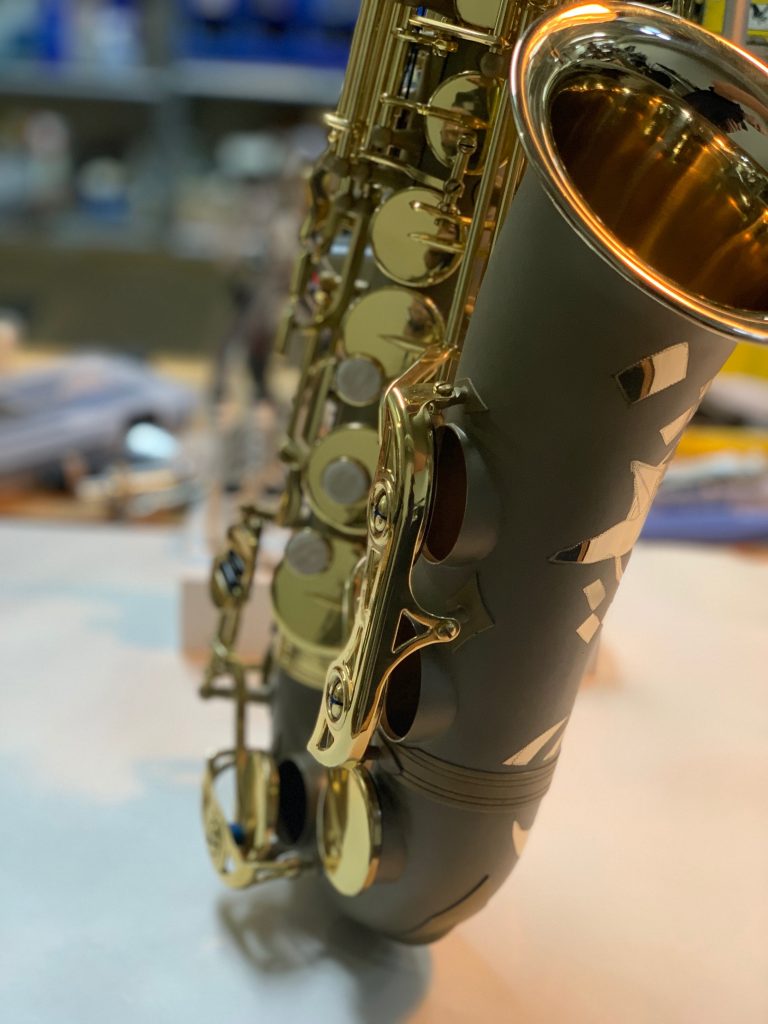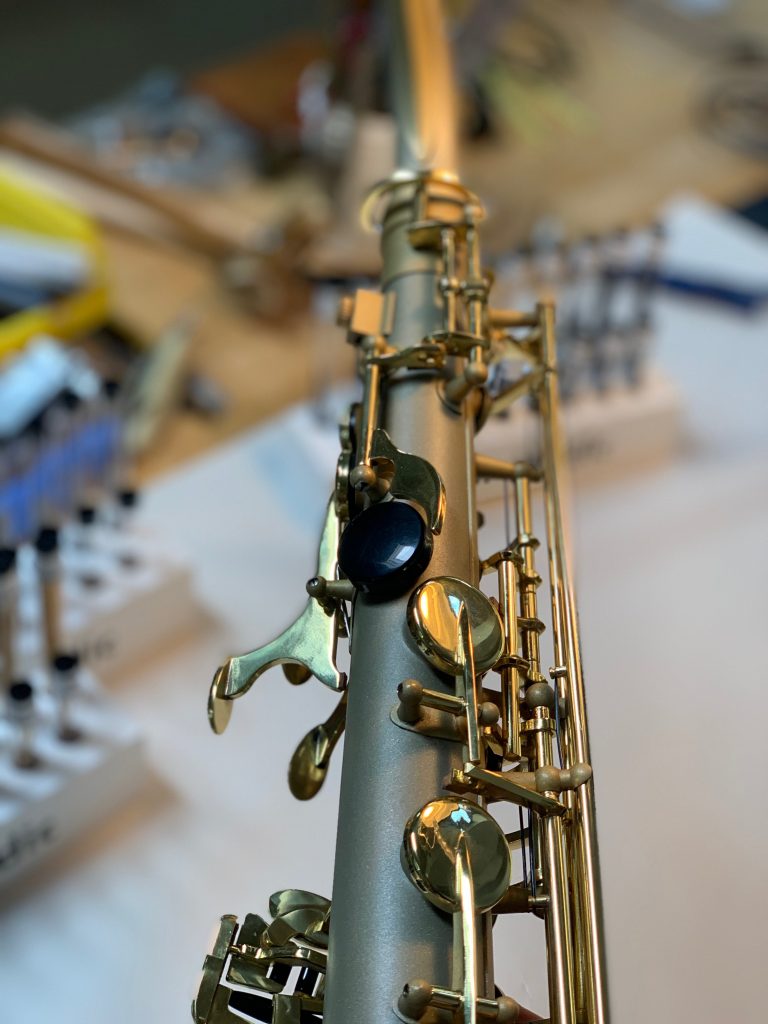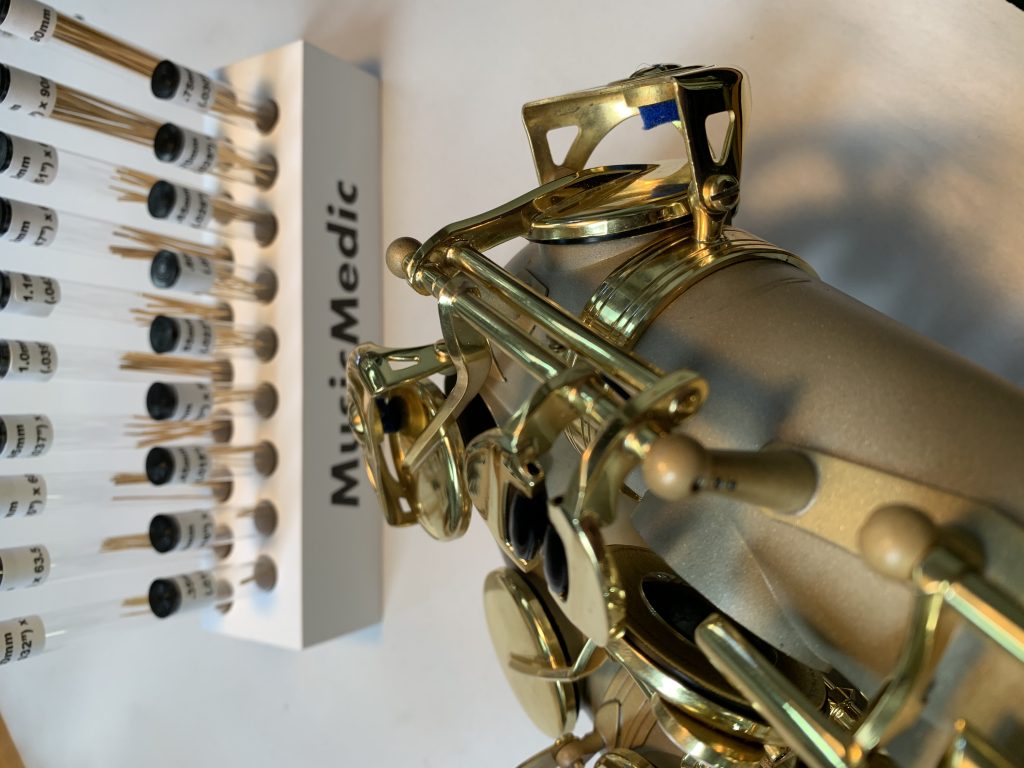Spring tension is often just taken as the feel of the horn, for better or worse. However, great mechanical work paired with a thoughtful set-up and methodically tensioned springs can work together to give the saxophone a solid, snappy, and responsive feel that takes down barriers between the instrument and the player.
There are lots of different kinds of needle springs, such as blued steel, nickel plated, stainless steel, and gold plated. There are differing opinions on the best curves and shapes, and where the useful arc occurs. The length and diameter play an important role as well, in addition to consideration as to what type of work the spring does during the operation of the key, such as sprung open or sprung closed. The shape of the spring cradle and its relation to the key also makes a difference.
This information is better saved for a lengthy technical article. For our purposes here, we are just seeking to better understand the spring’s role in the feel of the keywork. This understanding allows the player to be pickier and more precise, and to develop the sensitivity to feel for individual and collective spring function. The end result is a more intimate relationship between the player, the instrument, and the technician.
I’ve spent many years picking up horns, making adjustments, wiggling keys, and discovering the ideal tension and feel. I’ve found that if spring tensions are inappropriate or awkward, the players’ hands will experience unease and it introduces unnecessary hand tension. I can’t imagine what it would do to a piano player to suddenly have some random keys that are hard to press or too easy to press, and then I wonder why we as saxophone players don’t collectively demand the same from our instrument’s set-up.
The most obvious areas to begin addressing spring tension are the top and bottom stacks. The stacks are the same system repeated and have multiple springs acting on a single key action.
Let take a look at the top stack, beginning with the B, A, and G keys. When checking spring tension, you’re going to press the keys in order, keeping in mind that we need to test them as they would be played. For instance, the G key is not pushed down separately while being played, it is pressed in conjunction with the B and A keys. Even though they are not mechanically linked, you need to make sure you’ve pressed down B and A to properly understand the feel of G. B, A, and G, should all have the same feel, even though they are played by pressing different buttons which activate different combinations of pads and springs.
When you press B, the spring tension should feel exactly like the A. When you press the G, it should feel the same as B and A. Now check C compared to B. C should feel a bit heavier because it closes an extra pad and spring, but it should be quite close. If C is too heavy, the C or C# springs are likely too heavy. The C# pad spring should be very light, as it is on top of the stack and never directly activated.
Next, push Bis Bb and trill to A. When you play A coming from Bis Bb, it should feel a lot like when you play A coming from B, if just a little bit lighter. If A is far too light and it feels flappy when trilling, there’s a good chance that the Bis Bb spring is too heavy and the A key spring isn’t heavy enough. The A key, when pushed while holding down Bis Bb will always feel lighter but distributing those spring tensions properly will greatly minimize it. Note that Bis Bb key is never played alone. The sum total of Bis Bb and A should be equal to B.
Now feel the top and bottom stacks together. It should have an even feel as you progress downward. Does it feel like the bottom stack is really heavy and the top stack is really light? Sometimes I feel horns that are set up really well in both stacks but it feels like 2 separate horns. The goal is that top and bottom should feel the same, like you are playing one homogenous horn. This will give the instrument and the two hands a sense of balance and work towards our even feel.
Approach the bottom stack in the same manner as the top, considering that F, E, and D are the main keys and F# and forked Eb on vintage instruments are secondary keys which are indirectly activated. While you’re checking the bottom stack, hold down the top stack by pressing G so that the Bis Bb arm is not in the way of the F# arm. Take your time and feel each key compared to the key above it, when pressed additively. F, E, and D should feel the same, even though the F key will be closing two pads and springs. F# should feel a bit heavier than F or E, but not much. If F# feels heavy, but F, E, and D have a similar good feel, then there’s a good chance that the F# spring is too heavy.

After determining the feel of the two stacks, let’s go back to the top of the horn. The palm keys are pretty straight forward and should all feel the same. Check Palm D and Eb, they should feel the same. The part that is trickier is the inclusion of side High E since it is being played with the opposite hand and a different spring action.
Now try playing open octave C# to High E. You’re pressing Palm D and Eb on the left side and High E on the right side- do they feel similar? Both sides should have similar pressure. Palm F should feel the same as D, Eb, and side E. Then check High F# (if you have it). The entire grouping should feel cohesive. Sometimes the palm keys are heavier and that’s ok, as long as D, D#, E, F, F# add to the overall homogenous feel of the horn, and don’t detract from it.
Now we’ll check the octave key. When you press the octave key without the G key pressed it’s one tension, and once the G key is pressed the octave should be a little lighter. They should not feel distractingly different. When you play octave A, octave B, or octave C, you should feel an evenness from both sides, between the thumb on the octave key and the fingers pressing the top stack keys. The Octave Key tension should be similar to A. While you’re studying the top stack, put your neck on and push the octave key. How does it feel now? It should be comfortable and have a similar feel to pressing the B key. While you’re pushing the octave key, press G and trill from G to A. You can see the octave functioning, switching from body octave to neck octave. Is it snappy or sluggish? You can feel how the spring tension of the G key is changing and you may notice that the G keys feels slower coming up. When you play Octave A, you are adding in the tension of the neck octave. It will feel a little different. Adjustments to the G spring and the octave on key on the neck can really help improve the feel of the instrument.
Moving down the instrument, we’ll check the side keys. Check the Side C, considering that when you push Side C, you’re also pushing down the B key. They should feel similar coming in from the left and right hands. One side shouldn’t be heavy and the other side light. Go down to Side Bb, and when you press that, you’re also pressing down A on the top stack, and the two should have a similar feel. Those two groupings of Side C + B and Side Bb + A should have similar tension on both sides of the instrument to create a balanced feel, so you’re not moving the horn because of uneven pressure. Now press Alt F# to see how the spring tension feels. Feel Alt F# compared to F: it should feel similar but it may be a little heavier. If you don’t use it, that’s ok if it’s heavier.
Heading to the low end of the horn, check Low Eb and Low C. Try pressing F, E, and Low Eb, and also check the grouping of F, E, D, then Eb. They should feel the same. Eb is coming from a different angle, but it should feel similar in tension and comfortable to press.
Same thing with Low C. Press F, E, D, C. It should feel the same. Low C should also feel like Low C#, with even pressure coming in from both pinkies toward the center of the horn. Press D, C#, C in order, and try D to C compared with D to C#. Are they even?
We’ll finish our spring tension check in the Left Hand table. Press G on the top stack to get your left hand in the appropriate position. Push the G# touch piece: it should feel quick and snappy and have a clear open and a clear ending. If it doesn’t feel that way, there will be a problem throughout the LH table. Every lever in the LH table uses G#. Balance and tension here has to be exactly right to achieve a highly playable result. If G# feels good, check the C#.
Revisiting the Low C#, it should also feel easy, quick, and snappy, similar in feel to Low C. Checking the C#, B, and Bb levers alone, they should feel about exactly the same as one another. When you play B down to Bb, the Bb spring should be heavy enough to lift your finger back up when you’re coming up to B and quickly open up the Bb pad. So if your Bb spring is heavy enough, it means your B should be light enough as long as they have a similar feel separately.
ANALYZING THE RESULTS
There are a lot of mechanical actions taking place and many interactions between keys and their springs. They all come together and dictate the way that an instrument feels. If you can develop a sensitive and thoughtful understanding of your saxophone and its mechanisms, you may not be able to exactly correct the problem but, if you can feel inconsistencies in your key work you can have those corrected and work to remove barriers between you and your saxophone. It may be that the solution is as simple as adjusting a spring.
Happy repairing!




















